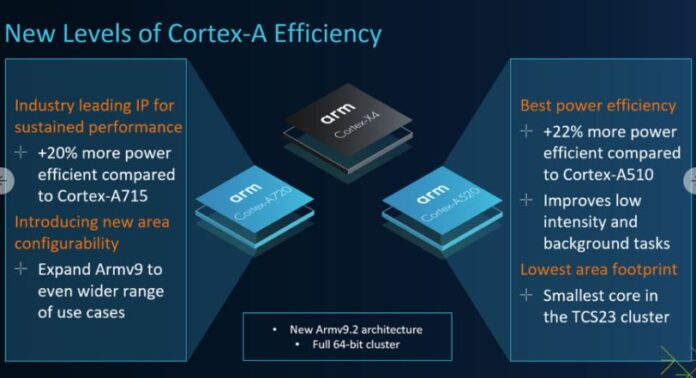Over the weekend, Arm showed off its vision for the next generation of flagship CPUs. As usual, these designs include CPUs in various sizes for different workloads. The ‘big’ chip this year is the Arm Cortex X4, the ‘medium’ chip is the Cortex A720, and the ‘small’ chip is the Cortex A520. The new chips should arrive in Android phones and Windows laptops in 2024.
Arm claims the big Cortex X3 chip will have 15 percent higher performance than this year’s X3 chip, and “40 percent better power efficiency.” The company also promises a 20 percent efficiency boost for the A700 series and a 22 percent efficiency boost for the A500.
The new chips are all built on the new ‘Armv9.2′ architecture, which adds a “new QARMA3 algorithm” for Arm’s Pointer Authentication memory security feature. Pointer authentication assigns a cryptographic signature to memory pointers and is meant to shut down memory corruption vulnerabilities like buffer overflows by making it harder for unauthenticated programs to create valid memory pointers. This feature has been around for a while, but Arm’s new algorithm reduces the CPU overhead of all this extra memory work to just 1 percent of the chip’s power, which hopefully will get more manufacturers to enable it.
FURTHER READING
RISC-Y Business: Arm wants to charge dramatically more for chip licenses
Arm’s SoC recommendations are usually a “1+3+4” design. That’s one big X chip, three medium A700 chips, and four A500 chips. This year the company is floating a new layout, though, swapping out two small chips for two medium chips, which would put you at a “1+5+2” configuration. Arm’s benchmarks—which were run on Android 13—claim this will get you 27 percent more performance. That’s assuming anything can cool and power that for a reasonable amount of time. Arm’s blog post also mentions a 1+4+4 chip—nine cores—for a flagship smartphone.
A sales pitch for a 1+5+2 CPU cluster for smartphones.
Enlarge / A sales pitch for a 1+5+2 CPU cluster for smartphones.
Arm
Arm is in a strange position because it only designs chips and doesn’t sell them or have control over how its designs hit the market. Arm lays out the blueprint, and actual chip companies like Qualcomm and MediaTek pick what they want and sometimes swap parts or alter designs. Qualcomm’s 2022 chip, the Snapdragon 8 Gen 2, didn’t stick to Arm’s design because it didn’t want to abandon 32-bit support yet. As the blog post mentions: “Alongside these CPU clusters, partners have the complete freedom to innovate their own for the next generation of consumer devices,” so who knows what the actual chips will look like.
Blame whoever or whatever you want in Arm’s path to market, but these launch events have a history of making performance claims that don’t align with what actually arrives in consumers’ hands. Just look at single core performance, where the company promised the X2 chip in 2021 would be 15 percent faster than the X1, then the next year said the X3 would be 25 percent faster than the X2. You won’t see this reflected in any benchmark, and in Geekbench, the X3-packing OnePlus 11 only gets 9 percent higher single-core scores than the X1-equipped Pixel 7a. If Arm’s claims lined up with reality, there should be around a 43 percent difference across that two-generation gap. Whether this is Qualcomm’s fault or due to insufficient cooling or troubles with the manufacturing process, you can’t take any of Arm’s performance claims too seriously.
If Arm’s claims do end up being representative of consumer chips, the X4’s 15 percent better performance and 40 percent better power efficiency sounds impressive, though. Assuming that manufacturers take that better power efficiency to clock the chip higher, we could be looking at a super-fast X4 chip. Today an iPhone 14 Pro embarrasses Arm’s best with 63 percent higher single-core scores in Geekbench compared to an X3-equipped Snapdragon 8 Gen 2. Multi-core scores aren’t great either, with the iPhone scoring 25 percent higher.
Will anyone build Arm’s 14-core mega chip?
Every year with these Arm flagship chip announcements, the company also includes a wild design for a giant mega-chip that usually never gets built. Last year the company’s blueprint monster was a design with eight Cortex X3 chips and four A715 cores, which the company claimed would rival an Intel Core i7. The biggest X3-based chip on the market is the Qualcomm Snapdragon 8cx Gen 3, which landed in a few Windows laptops. That was only a four X3/four A715 chip, though.
Enlarge
Arm
This year’s mega chip is a 14-core monster with 10 Cortex X4 chips and four A720 chips, which Arm says is meant for “high-performance laptops.” Arm calls the design the company’s “most powerful cluster ever built,” but will it ever actually be built? Will it ever be more than words on a page?
Last month The Financial Times published an article claiming Arm was planning to build one of its chip designs as a “prototype” that would “showcase the capabilities of its designs.” The report didn’t nail down an exact design or purpose for this chip other than saying it was “more advanced” than anything in the company’s lineup. With Arm pushing these giant laptop chips for four years now and no one taking them up on the offer, we speculate that Arm’s self-built chip is going to involve finally making one of these designs a reality.
Next up in the Arm launch process will be Qualcomm’s announcement around the end of the year detailing what the consumer version of all these designs will look like.








